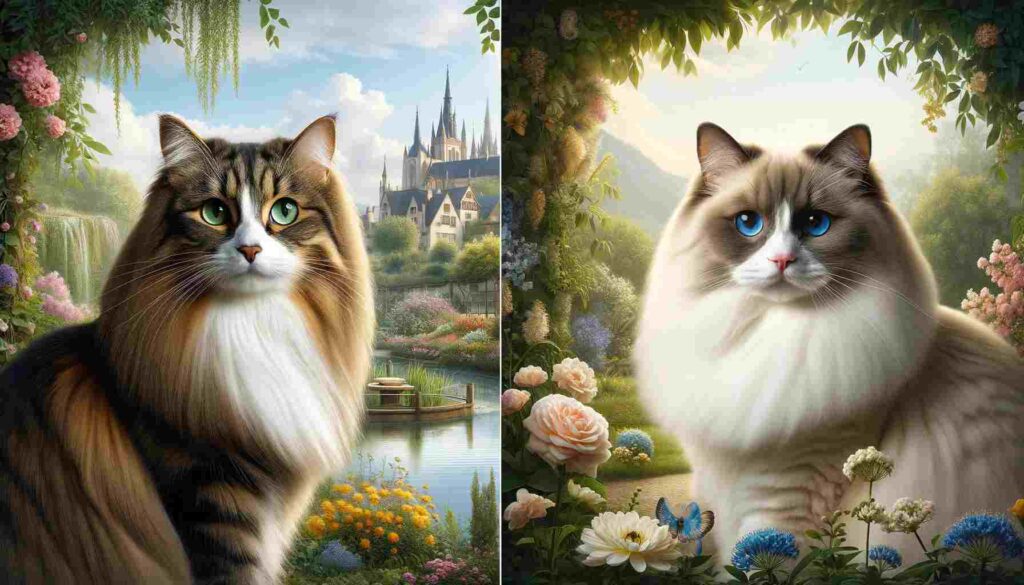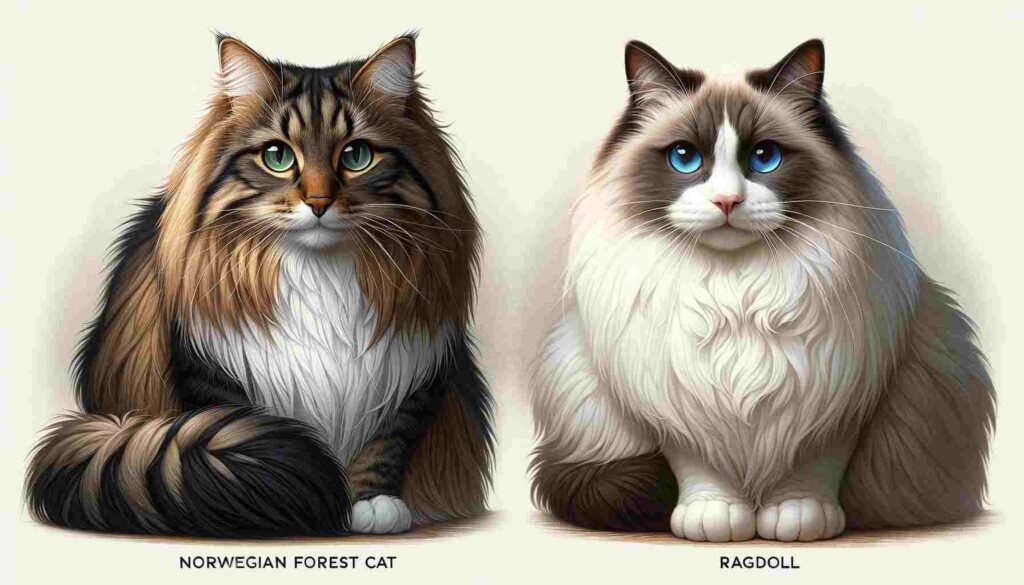Are you considering adopting a cat and can’t decide between a Norwegian Forest Cat vs Ragdoll? We’ve got you covered. In this comprehensive breed comparison, we’ll explore the similarities and differences between these two popular breeds, helping you make an informed decision about which one is the perfect fit for you.
Ragdoll and Norwegian Forest Cat Origin and History
The Norwegian Forest Cat, also known as “Wegie,” has a rich history that dates back to Viking times. This breed is native to Norway, where it was well-adapted to the cold Scandinavian climate. The Norwegian Forest Cat is believed to have been companions to sailors and was featured in Scandinavian mythology as a mystical and resilient creature.
The Ragdoll is a relatively modern breed, originating in the United States in the 1960s. Ann Baker, a breeder in California, developed the Ragdoll breed by selectively breeding long-haired cats with gentle temperaments. Ragdolls are known for their characteristic “floppy” nature when picked up, which contributed to their name.
Ragdoll cat and Norwegian forest cats Physical Appearance
Norwegian Forest Cats are known for their large, muscular frames. They have strong, sturdy bodies that reflect their heritage as outdoor hunters. Ragdolls, on the other hand, are also large but tend to have a softer, more relaxed build. While both breeds are sizable, Norwegian Forest Cats are more rugged and athletic compared to the more docile Ragdolls.
The coat of the Norwegian Forest Cat is dense, water-repellent, and well-suited to harsh winters. It has a thick double-layered fur that requires regular grooming, especially during seasonal shedding. The Ragdoll’s coat is silky, semi-long, and less prone to matting, making it easier to manage with regular brushing.
Ragdolls come in pointed color patterns with striking blue eyes, while Norwegian Forest Cats have a wider variety of coat colors and eye shades.

Norwegian Forest Cat vs Ragdoll Temperament and Personality
When it comes to temperament and personality, Norwegian Forest Cats and Ragdolls are known for their distinct characteristics. While both breeds are highly sought-after for their affectionate nature, the Ragdoll is known for being particularly docile and laid-back. On the other hand, the Norwegian Forest Cat tends to be more active and independent.
Ragdolls are famously affectionate and love being around their owners. They’re incredibly gentle and make wonderful family pets, often enjoying cuddling up with both adults and children. Their docile nature means they’re unlikely to scratch or bite, making them an ideal family pet.
Meanwhile, Norwegian Forest Cats are known for their playful, energetic personalities. They love to climb and explore, making them the perfect choice for a family with an active lifestyle. Although they enjoy being around their owners, they don’t require constant attention and are happy to entertain themselves.
| Breed | Temperament |
|---|---|
| Norwegian Forest Cat | Energetic, independent |
| Ragdoll | Affectionate, docile |
Ragdolls and Norwegian Forest Cats Care and Grooming
Both Norwegian Forest Cats and Ragdolls have dense, water-resistant coats that require regular grooming to keep them in good condition.
It’s essential to brush their fur regularly to prevent matting and tangling. However, the two breeds have different undercoats, and their grooming requirements vary.
Norwegian Forest Cats have a thick, woolly undercoat that helps them stay warm in cold weather. They need to be brushed weekly to remove any loose hair and prevent mats from forming. Pay extra attention during shedding seasons and increase brushing frequency to twice a week.
On the other hand, Ragdolls have a softer undercoat that is prone to tangling. They require daily grooming to keep their coat tangle-free and healthy.
Both breeds benefit from bathing occasionally to keep their fur and skin clean and healthy.
Investing in proper grooming tools such as a slicker brush and a metal comb is necessary, and taking them to a professional groomer is also an option.

Norwegian Forest Cat vs Ragdoll
Health and Lifespan
When choosing a feline companion, it is important to consider the potential health issues and lifespan of the breed. Both Norwegian Forest Cats and Ragdolls typically live between 12 to 16 years and have similar lifespans. However, they are both prone to certain health issues that owners should be aware of.
Health Issues
One common health issue among Norwegian Forest Cats and Ragdolls is hypertrophic cardiomyopathy, a disease that affects the heart muscle. It is important to have regular checkups with a veterinarian to monitor the cat’s heart health, especially if there is a family history of the disease. Other potential health issues for Norwegian Forest Cats include hip dysplasia, while Ragdolls may be prone to bladder stones.
Grooming for Health
Proper grooming for both breeds can help prevent health issues. Norwegian Forest Cats have a water-resistant coat and a thick undercoat that requires frequent brushing to prevent matting. Ragdolls also have a thick coat that should be brushed regularly.
| Norwegian Forest Cat | Ragdoll | |
|---|---|---|
| Lifespan | 12-16 years | 12-16 years |
| Common Health Issues | Hypertrophic cardiomyopathy, hip dysplasia | Hypertrophic cardiomyopathy, bladder stones |
| Grooming Needs | Regular brushing to prevent matting due to thick undercoat and water-resistant topcoat | Regular brushing due to thick coat |
Compatibility with Families and Other Pets
When it comes to choosing a feline companion that can coexist peacefully with other household pets and children, both the Norwegian Forest Cat and Ragdoll are popular choices.
The Norwegian Forest Cat is known for being friendly, outgoing, and social, making them excellent companions for families with children and other pets. They are also highly adaptable, making them suitable for households with busy schedules.
The Ragdoll is also a gentle, affectionate, and laid-back breed that enjoys the company of their owners and other animals. They are well-behaved and have a playful and calm temperament that makes them an excellent fit for families with young children.
Both breeds are highly compatible with other pets and children, which makes them an excellent choice for families who want a feline companion that can share their life with them.
| Breed | Suitability with Children | Suitability with Other Pets |
|---|---|---|
| Norwegian Forest Cat | Excellent | Excellent |
| Ragdoll | Excellent | Excellent |
Ragdoll vs Norwegian Forest Cats Training and Intelligence
When it comes to training and intelligence, both Norwegian Forest Cats and Ragdolls are highly trainable and intelligent. However, research indicates that Norwegian Forest Cats are more receptive to training than Ragdolls.
Both breeds can learn basic commands and simple tricks such as ‘sit’, ‘stay’, and ‘fetch’ using positive reinforcement techniques, but Norwegian Forest Cats tend to learn more quickly and efficiently.
To achieve positive results while training your feline friend, start the training process early and keep training sessions short, around 5-10 minutes long. When training, use treats or positive reinforcement such as praise to create a positive association for your cat.
Price and Availability
Looking to add a Norwegian Forest Cat or Ragdoll to your household? It’s important to understand the costs associated with purchasing a kitten and finding a reputable breeder. The price of these breeds can vary depending on several factors such as age, coat color, and bloodline.
On average, Norwegian Forest Cats tend to be slightly more affordable than Ragdolls, with prices typically ranging from $500 to $1,500. Ragdolls, on the other hand, tend to be a bit more expensive with prices ranging from $1,000 to $2,500 or more.
When searching for a breeder, it’s essential to do your research to ensure you find someone reputable and trustworthy. Look for breeders who are registered with a recognized cat association to help ensure you get a healthy kitten.
If you’re looking to adopt a Norwegian Forest Cat or a Ragdoll, you can check local shelters or rescues. These organizations often have kittens available for adoption at a lower cost than buying from a breeder.
Price Comparison Table
| Breed | Average Price Range |
|---|---|
| Norwegian Forest Cat | $500 – $1,500 |
| Ragdoll | $1,000 – $2,500+ |
Conclusion
After carefully examining the similarities and differences between the Norwegian Forest Cat and the Ragdoll breeds, we hope you have gained valuable insights about each feline companion. Ultimately, choosing the right breed for your lifestyle and personality is crucial to ensuring a happy and healthy relationship with your pet.
Consider factors such as temperament, physical appearance, grooming needs, health, compatibility with children and other pets, trainability, and price when making your decision. Remember that owning a cat is a long-term commitment, so take your time in making a decision.
If you are still uncertain about which breed to choose, we suggest reaching out to reputable breeders or consulting with a veterinarian who can assist you in determining which breed is the right fit for you. Regardless of which breed you ultimately choose, we wish you many years of love and companionship with your furry friend.
FAQs
Q: What are the main differences between the Norwegian Forest Cat and Ragdoll cat breeds?
A: While both are large and friendly cat breeds, the Norwegian Forest Cat is known for its thick, water-repellent coat and strong hunting instincts, while Ragdolls are more laid-back and have semi-long, silky fur.
Q: What sets the Norwegian Forest Cat breed apart from other popular cat breeds like the Maine Coon?
A: Norwegian Forest Cats are recognized for their unique double coat, adaptable nature, and strong climbing abilities, distinguishing them from the Maine Coon and other breeds.
Q: Are there any similarities between Ragdoll and Norwegian Forest Cat breeds?
A: Both breeds share the trait of being affectionate and gentle with their families, making them popular choices for households seeking loving and sociable companion animals.

Hey guys, My name is Simon Smith. I’m from Canada and live near Victoria
I live with my sweet family and have 20+ Ragdolls of different types. I love them as my children. My profession is as a hotel manager.
I love to keep Ragdolls and grow their breeder case. I have 7 years of experience.
I’m an expert in cat care. So, I’m here to provide you with new information about my cats daily. This is my blog website, so I request that you kindly visit our site daily.
If you’re a Ragdolls lover and you have any questions or confusion about cats, text me on the Contact Us page or Gmail.
Thank u
